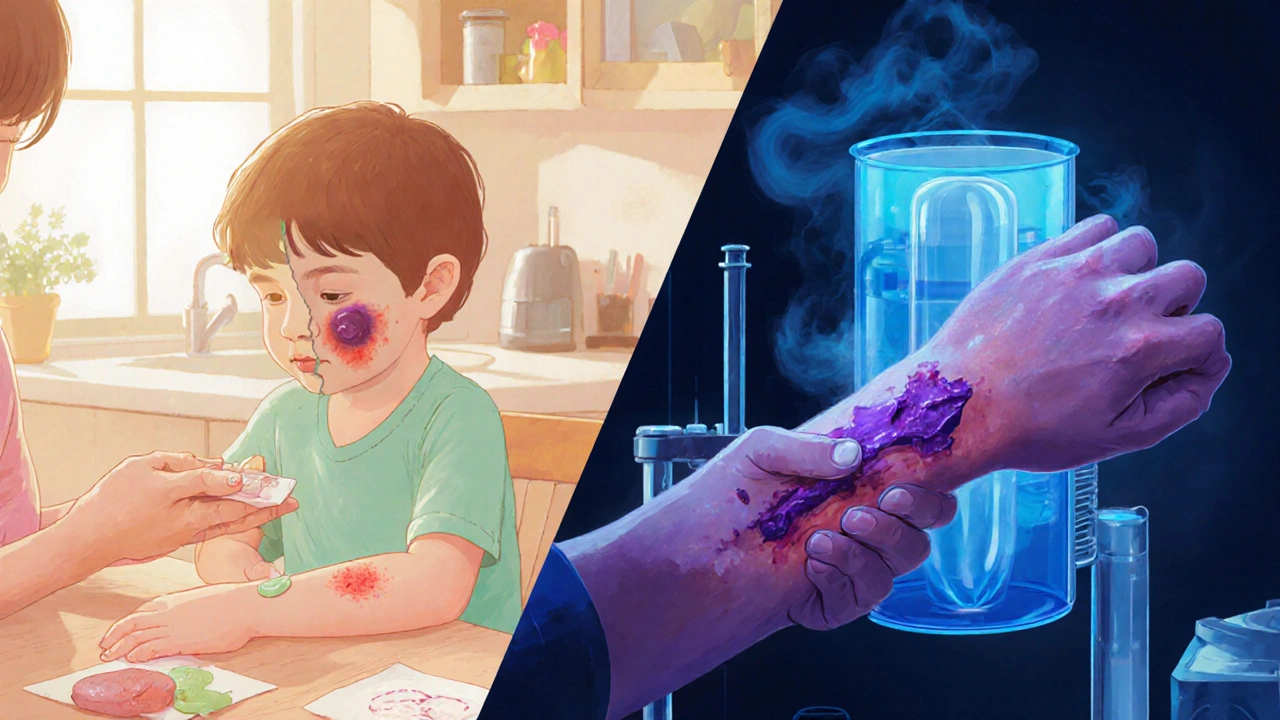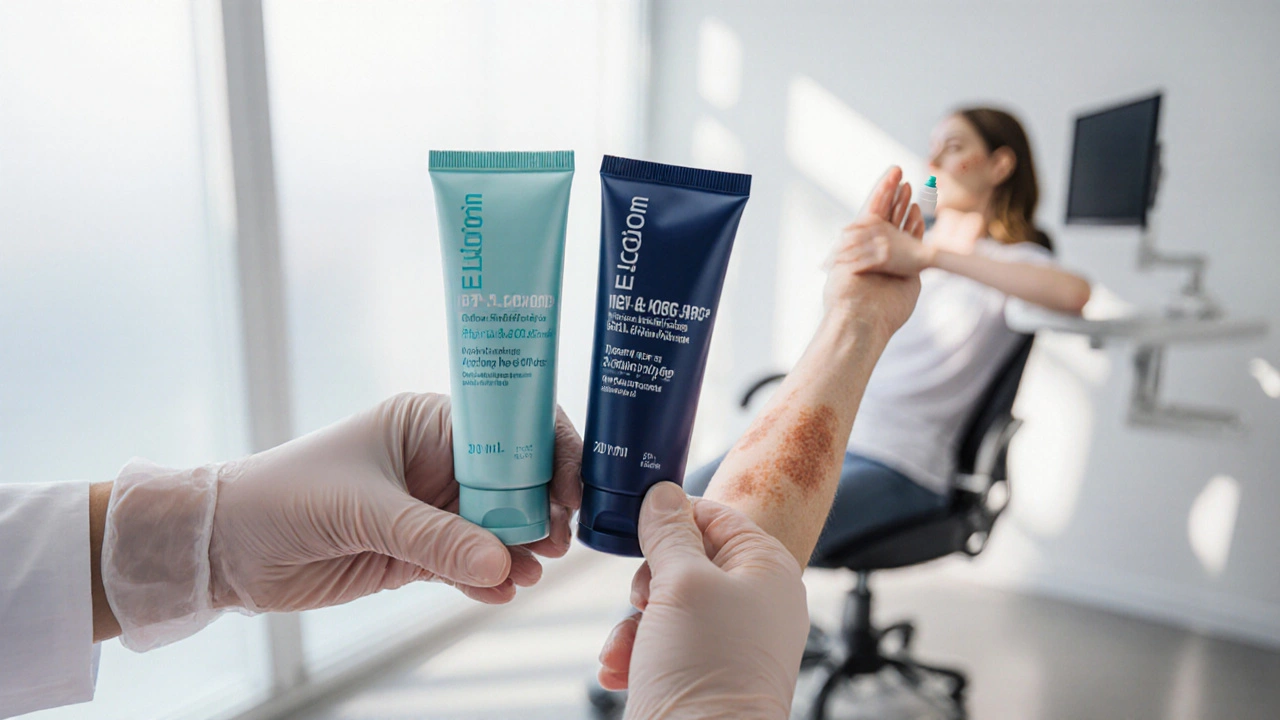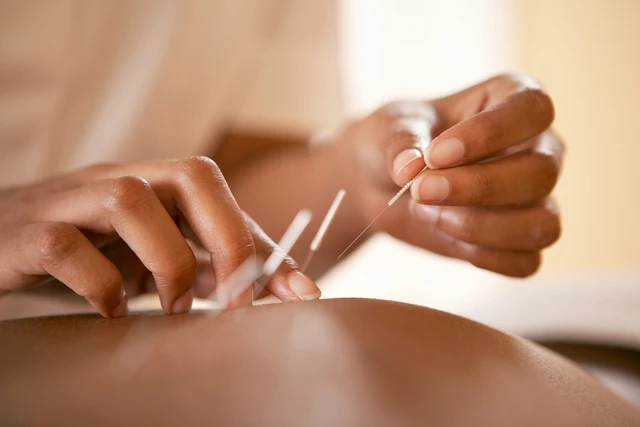Topical Steroid Potency Selector
Select your condition and body area to get a recommended steroid potency level.
Elocon is a topical corticosteroid that delivers the synthetic glucocorticoid mometasone furoate for treating inflammatory skin conditions.
Elocon remains a go‑to prescription for moderate‑to‑high potency skin inflammation.
Quick Take
- Elocon (mometasone) sits in the medium‑high potency range.
- Betamethasone and clobetasol are higher‑potency options.
- Hydrocortisone and desonide are low‑potency, OTC choices.
- Formulations vary: cream, ointment, lotion, and spray.
- Prescription status, side‑effect risk, and condition severity guide selection.
How Elocon Works
When you apply Elocon, the mometasone furoate molecule penetrates the epidermis and binds to intracellular glucocorticoid receptors. This binding triggers a cascade that suppresses pro‑inflammatory genes (like IL‑1, TNF‑α) and ramps up anti‑inflammatory proteins. The net effect is reduced redness, itching, and swelling within 24‑48hours.
Potency Spectrum of Topical Corticosteroids
Clinicians categorize steroids into four groups based on strength. The scale helps match drug potency to disease severity and body‑site sensitivity.
- Low potency: Hydrocortisone, Desonide - suitable for delicate areas (face, intertriginous zones).
- Medium potency: Mometasone (Elocon), Triamcinolone - used for eczema, psoriasis, and allergic dermatitis on trunk and limbs.
- High potency: Betamethasone, Fluocinonide - reserved for resistant plaques or thick plaques.
- Super‑high potency: Clobetasol, Halobetasol - short‑term rescue for severe psoriasis or lichen planus.
Leading Alternatives to Elocon
Below are the most common steroids that clinicians consider when Elocon isn’t the perfect fit.
Betamethasone (dipropionate) is a high‑potency corticosteroid often chosen for thick plaques of psoriasis or stubborn eczematous lesions. It comes as cream, ointment, or lotion and requires a prescription in most markets.
Hydrocortisone is the classic low‑potency, over‑the‑counter option. With a 1% formulation it’s safe for facial use and for children, though it may not control moderate‑to‑severe inflammation.
Clobetasol propionate represents the super‑high potency end. It’s a rescue drug for severe psoriasis flares, but prolonged use can cause skin atrophy, so doctors limit treatment to two weeks.
Triamcinolone acetonide lands in the medium‑potency bracket, similar to mometasone, but with a slightly higher risk of skin thinning when used on thin skin. It’s popular for ulcerated eczema.
Fluticasone propionate, better known as an inhaled asthma medication, also appears in a topical cream (0.05%) for dermatitis. Its potency is comparable to mometasone, making it a viable alternative when Elocon is unavailable.
Desonide is a low‑potency prescription steroid often used on the face or intertriginous zones where stronger steroids could cause tearing.

Side‑Effect Profile Across the Class
All topical steroids share a core set of possible adverse effects, but the frequency and severity rise with potency.
- Skin atrophy (thinning) - highest with clobetasol, moderate with betamethasone.
- Telangiectasia (spider veins) - more common in high‑potency use.
- Hypothalamic‑pituitary‑adrenal (HPA) axis suppression - rare with low‑potency agents, possible with prolonged high‑potency use.
- Perioral dermatitis - can appear with any steroid applied near the mouth, especially if occluded.
Direct Comparison Table
| Drug | Potency | Typical Uses | Formulations | Prescription? | Common Side‑effects |
|---|---|---|---|---|---|
| Elocon (mometasone furoate) | Medium‑high | Eczema, psoriasis, allergic dermatitis | Cream, ointment, lotion, spray | Yes | Mild skin thinning, burning |
| Betamethasone dipropionate | High | Thick plaques, resistant eczema | Cream, ointment | Yes | More pronounced thinning, striae |
| Hydrocortisone 1% | Low | Minor irritations, facial eczema | Cream, ointment | No (OTC) | Very low risk |
| Clobetasol propionate | Super‑high | Severe psoriasis, lichen planus | Ointment, gel, scalp solution | Yes | Significant atrophy, telangiectasia |
| Triamcinolone acetonide | Medium | Ulcerated eczema, dermatitis | Cream, ointment | Yes | Moderate thinning, burning |
| Fluticasone propionate (topical) | Medium‑high | Contact dermatitis, atopic eczema | Cream 0.05% | Yes | Similar to mometasone |
| Desonide | Low | Facial eczema, intertriginous areas | Cream, lotion | Yes (prescription) | Minimal |
Choosing the Right Steroid for Your Patient
Think of the decision as a flowchart. First, assess severity:
- If the rash is mild and limited to the face or groin, start with a low‑potency agent such as desonide or hydrocortisone.
- For moderate plaques on trunk or limbs, a medium‑potency option like Elocon or triamcinolone usually does the job.
- If lesions are thick, hyperkeratotic, or resistant to medium‑potency treatment, step up to a high‑potency steroid (betamethasone) for a short course.
- Only in severe, refractory cases should a super‑high potency steroid (clobetasol) be considered, and never for more than 2weeks.
Next, consider the body site. Thin skin (eyelids, genitalia) tolerates only low potency; thick skin (palms, soles) may need a higher strength to penetrate.
Finally, factor in patient‑specific risks: age, diabetes, immunosuppression, or a history of steroid‑induced skin changes. In children, most clinicians avoid high‑potency steroids unless absolutely necessary.
Practical Tips for Safe Use
- Apply a thin layer - “finger‑tip unit” (FTU) guidelines help prevent over‑application.
- Use occlusion (plastic wrap) only when directed; it can boost potency 2‑3×.
- Limit continuous use: most regimens recommend 2‑4weeks, followed by a taper or drug‑holiday.
- Monitor for signs of atrophy: thin skin, easy bruising, or stretch marks.
- Educate patients to report systemic symptoms (fatigue, nausea) that could hint at HPA‑axis suppression.
Related Concepts and Next Steps
Understanding potency classification is essential when you move beyond Elocon. The WHO’s ‘corticosteroid potency ladder’ provides a global reference. Additionally, the concept of “steroid‑sparing agents” - such as calcineurin inhibitors (tacrolimus, pimecrolimus) - becomes relevant for patients who develop steroid resistance.
Future reading could explore:
- “When to switch from topical to systemic therapy” - a deep dive into oral corticosteroids and biologics.
- “The role of moisturizers and barrier repair in enhancing steroid efficacy”.
- “Emerging non‑steroidal anti‑inflammatories for eczema”.

Frequently Asked Questions
Is Elocar the same as Elocon?
No. Elocon contains mometasone furoate, while Elocar (a made‑up name) is not an FDA‑approved product. Always verify the active ingredient before buying.
Can I use Elocon on my face?
Yes, but only for short periods (2‑4weeks) and in a thin layer. For chronic facial eczema, a lower‑potency steroid like desonide is usually safer.
How does mometasone compare to betamethasone?
Mometasone (Elocon) is considered medium‑high potency, whereas betamethasone dipropionate sits in the high‑potency range. Betamethasone may work faster on thick plaques but carries a higher risk of skin thinning.
Is an over‑the‑counter steroid as effective as a prescription one?
OTC steroids like 1% hydrocortisone are effective for mild irritations. Prescription steroids such as Elocon provide stronger anti‑inflammatory action and are needed for moderate to severe conditions.
What should I do if my skin thins after using a steroid?
Stop the steroid immediately, switch to a low‑potency agent or a non‑steroidal alternative, and consult your dermatologist. Moisturizers with ceramides can aid barrier recovery.
Can children use Elocon safely?
Yes, but only under pediatric guidance. Dosing by body surface area and limiting treatment duration are critical to avoid systemic absorption.





Marcia Bailey
September 27, 2025 AT 01:51When you’re dosing Elocon, remember the finger‑tip unit rule: one unit covers roughly a two‑inch circle, so you don’t end up over‑applying and risking skin thinning 😊. Start with a thin layer and spread evenly; you’ll get the anti‑inflammatory effect without the extra side‑effects. Also, keep the treatment window to 2–4 weeks and then taper or switch to a lower‑potency steroid if the rash persists.
Hannah Tran
October 1, 2025 AT 16:57From a pharmacodynamic standpoint, mometasone furoate exhibits a high receptor affinity paired with a moderate systemic absorption profile, making it a prime candidate for medium‑high potency regimens. However, clinicians often underdose patients on thin skin areas, which can blunt therapeutic outcomes and perpetuate chronic inflammation. I urge you to calibrate the potency ladder meticulously-don’t just default to “medium” because it sounds safe; match the vehicle, the lesional thickness, and the occlusion factor before committing.
Mark Conner
October 6, 2025 AT 08:04Look, we’ve got some of the best dermatology guidelines in the world-why would anyone settle for a cheap OTC cream when a prescription‑strength Elocon can knock out that eczema in days? The US market gives us access to high‑potency options that most other countries can’t even import, so use them wisely and stop whining about side‑effects you could avoid with proper usage.
Abraham Gayah
October 10, 2025 AT 23:11This steroid ladder feels like climbing Everest!
rajendra kanoujiya
October 15, 2025 AT 14:17Honestly, comparing topical steroids to mountaineering is a stretch; the real issue is that many patients self‑prescribe without a dermatologist’s supervision, leading to misuse regardless of the “height” of the drug.
Caley Ross
October 20, 2025 AT 05:24That’s a solid breakdown, but in practice I’ve seen patients who can’t even follow the finger‑tip unit rule, so the real challenge is patient education, not just picking the right potency.
Bobby Hartono
October 24, 2025 AT 20:31First off, let me say that navigating the landscape of topical corticosteroids can feel like walking through a dense forest with a shaky compass, especially when you’re bombarded with terms like “medium‑high potency” and “super‑high potency.” The good news is that the classification system isn’t as mysterious as it appears once you understand the underlying principles of drug penetration, receptor binding, and skin thickness. For example, Elocon’s mometasone furoate is formulated to straddle the line between efficacy and safety, delivering enough anti‑inflammatory activity to tame moderate to severe eczema while still being relatively forgiving on thinner skin sites if used correctly. On the other hand, agents like clobetasol push the potency envelope so far that even a short course can leave permanent atrophic changes if you’re not careful. It’s also worth noting that the vehicle-cream versus ointment versus lotion-plays a massive role in how much of the drug actually reaches the epidermis; ointments typically enhance occlusion and therefore potency, whereas lotions might be better suited for hairy or intertriginous areas. In practice, I always start patients on the lowest effective potency and only step up after a trial period of two weeks, because the skin’s adaptive response can sometimes render a lower‑strength steroid sufficient. When escalating, keep an eye on the total cumulative dose and avoid using occlusive dressings unless specifically directed, as they can boost absorption three‑fold. Moreover, the systemic safety profile of mometasone remains favorable, but you still want to monitor for hypothalamic‑pituitary‑adrenal axis suppression in long‑term, high‑dose scenarios. Don’t forget that patient adherence hinges on how comfortable the formulation feels; a greasy ointment can be a deal‑breaker for many, which is why offering alternatives like spray or lotion can improve compliance. Finally, educating patients about the “finger‑tip unit” method and setting realistic expectations for improvement-usually within 48‑72 hours-can dramatically reduce the temptation to over‑apply, which is the biggest driver of side‑effects across the board. All in all, the key is a balanced, individualized approach that respects both the pharmacology of the steroid and the everyday realities of the patient’s life.
George Frengos
October 29, 2025 AT 11:37I appreciate the comprehensive overview; your emphasis on starting low, monitoring systemic absorption, and tailoring the vehicle to the patient really encapsulates best practice. This nuanced approach helps clinicians avoid the pitfalls of over‑potent therapy while still achieving rapid remission.
Charles Markley
November 3, 2025 AT 02:44One must acknowledge that the pharmacokinetic disparities among corticosteroid esters render a simplistic “potency ladder” insufficient; the lipophilicity of mometasone merely approximates its dermal reservoir capacity, yet it pales in comparison to the quantum of cutaneous binding exhibited by fluorinated betamethasone derivatives.
L Taylor
November 7, 2025 AT 17:51Life is like a skin barrier you apply steroids to you either leak or you heal
Matt Thomas
November 12, 2025 AT 08:57Look, the article has some good points but it also misses the mark on practical usage‑you cant just spray Elocon everywhere and expect miracles, that’s definitely not how it works.
Nancy Chen
November 17, 2025 AT 00:04Ever notice how the big pharma “experts” push the newest high‑potency steroid like clobetasol as the only solution, while quietly shelving cheaper alternatives that could keep us all safe from the hidden side‑effects they don’t want you to know about?
Chloe Ingham
November 21, 2025 AT 15:11It’s like a twisted theater where the spotlight is always on the blockbuster drug, and the understudies – the low‑potency creams – are left gathering dust in the wings, never getting a chance to prove they can save the day.
Mildred Farfán
November 26, 2025 AT 06:17Oh sure, because nothing says “fun” like reading a dense table of steroid potencies while waiting for your rash to clear – truly the highlight of any weekend.